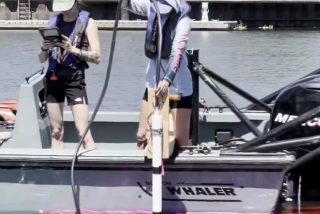Hydrilla Removal Will Allow Reopening of Lake Murray Shores
- Share via
Nearly 10 years ago, in the calm waters of Lake Murray, a monster took root.
Biologists were consulted and fumigants were used, but the monster only grew stronger. Soon ducks were walking on top of the monster to cross the lake.
The monster known as hydrilla, a fast-growing weed, strangled the lake, depleting the water of its oxygen and killing game fish. Today, the last remnants of hydrilla are being removed from the lake, which has been closed to recreational activity for eight years.
The lake is being dredged and will be reopened beginning Memorial Day weekend for shoreline recreation, Councilman Dick Murphy said Thursday.
“Residents can finally reclaim this resource,” Murphy said. “The eradication has taken us from 100 acres of hydrilla to a few hundred plants in isolated areas.”
The lake will be open daily from 7 a.m. to 5 p.m. beginning May 26 for picnicking, bicycling, jogging and other activities out of the water, Murphy said at a press conference at the southeastern tip of the lake known as Alvarado Bay.
Fishing and boating will still be prohibited in the 200-acre city reservoir until the eradication of hydrilla is completed, sometime next year, Murphy said.
Hydrilla, found in only five or six California lakes or canals, could be carried from Lake Murray on boat bottoms or fishing poles to contaminate other lakes, a county agriculture official said.
Commonly found in pet store fish tanks, the South American weed probably found its way into Lake Murray when a fish owner decided to dump his tank there, said Ray Rinder, assistant county agriculture commissioner. The remains of an aquarium were found in the lake when it was quarantined in 1977 to keep the weed from spreading elsewhere, Rinder said.
The city has spent more than $200,000 in the last eight years to eliminate the hydrilla, Rinder said.
“We can completely rid ourselves of the plants,” Rinder said. “The problem is that hydrilla can reproduce in five different ways, and it’s a matter of getting to that last single one. It’s like trying to get rid of that last hair.”
Divers, armed with a vacuuming device, will continue to suck out the plant “roots and all, until the last plant is gone,” Murphy said.
The city is spending $10,000 to install 30 picnic tables and landscape the area near Alvarado Bay, Murphy said.
Nearby residents said they have continued to jog or bike around the lake despite the quarantine, but they are excited at the prospect of being able to do it legally.
“I’m not allowed to come down here by myself,” said Tracey Wapnick, 14, who was riding her bike with a friend on the west side of the lake. “But if it is opened and more people are down here, I will feel safer.”
Jim Hull, 42, said it is the fishing that he misses.
“I used to do a lot of fishing here,” Hull said. “I’ll be the first one in there fishing when they open it up again for that.”
Another fisherman agreed.
“I am just dying to fish here,” Ron Goff, 39, said. “I’ve heard reports of big bass in there.”
More to Read
Sign up for Essential California
The most important California stories and recommendations in your inbox every morning.
You may occasionally receive promotional content from the Los Angeles Times.










